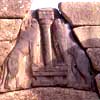HISTORY OF AEGEAN CIVILIZATION
HISTORY OF AEGEAN CIVILIZATION
The missing Minoans: 20th - 15th century BC
It is astonishing that history should lose all track of a civilization which lasts for six centuries, makes superb ceramics and metalwork, trades extensively over a wide region, and houses its rulers in palaces elaborately decorated with superb fresco paintings. Yet this has been the case with the Minoans in Crete, until the excavation of Knossos.
We still know little more about them than is suggested by Minoan art and artefacts. It is typical that the name they have been given derives from a figure of myth rather than history - Minos, the legendary king of Crete whose pet creature is the Minotaur, a monster with the body of a man and the head of a bull which feeds on young human flesh.
Administrative records and accounts are kept on clay tablets in a script as yet undeciphered (it is known as Linear A). Archaeological discoveries reveal that trade is carried on round the entire Mediterranean coast from Sicily in the west to Egypt in the southeast.
The reason for their preservation is the eruption of the island's volcano in about 1525 BC. Like Pompeii a millennium and a half later, Akrotiri is pickled in volcanic ash.

Defensive walls are notably absent in Minoan Crete, as also are paintings of warfare. This seems to have been a peaceful as well as a prosperous society. But its end is violent. In about 1425 BC all the towns and palaces of Crete, except Knossos itself, are destroyed by fire. It is not known whether this is a natural disaster, which gives Greeks from the mainland their chance, or whether Greek invaders destroy Minoan Crete - keeping only the main palace for their own use. But it is certain that the next generation of rulers introduce the culture of mainland Mycenae, and they keep their accounts in the Mycenaean script - Linear B. It seems probable that a Mycenaean invasion ends Minoan civilization.
The first Greek civilization: from the 16th century BC
Archaeology reveals the rulers of these early Greeks to have been as proud and warlike as Homer suggests.

At Mycenae it is the gateway through the walls which proclaims power, with two great lions standing above the massive lintel.
By the 14th century the graves themselves become more in keeping with the status of their occupants, with the development of the tholos or 'beehive' style of tomb. The most impressive is the so-called Treasury of Atreus at Mycenae, with its high domed inner chamber (independently pioneered in Neolithic Western europe 2500 years previously).
The Mycenaean warrior's weapons are a bronze sword and a bronze-tipped spear. His shield is of stiff leather on a wooden frame. Similar weapons are used, several centuries later, by the Greek Hoplites.
Trade and conquest: 13th - 12th century BC
Mycenaeans trade the length of the Mediterranean, from the traditional markets of the eastern coasts to new ones as far away as Spain in the west. They also have long-range trading contacts with Neolithic societies in the interior of Europe.
In Homer's poem it takes many years before Troy is finally subdued. If there is truth in this, the war perhaps fatally weakens the Greeks. Certainly archaeology reveals that the successful Mycenaean civilization comes to an abrupt end not very much later - in about 1200 BC.
The most likely answer is the southern and western coasts of Anatolia. The rulers of Anatolia, the Hittites, are among their victims. So also are the communities of the eastern Mediterranean, where some of the Sea Peoples settle - to become known as the Philistines.
Doric and Ionic: from the 12th century BC
The Dorian incursion plunges Greece into a period usually referred to as a dark age. But Dorian military traditions survive to play a profound part in the heyday of classical Greece. The ruthlessly efficient Spartans will claim the Dorians as their ancestors, and model themselves upon them.
With the encouragement of Athens, from about 900 BC, non-Dorian Greeks migrate to form colonies on the west coast of Anatolia. These colonies eventually merge to form Ionia. In subsequent centuries Ionia, with Athens, becomes a cradle of the classical Greek civilization. So there is a genuine continuity from Mycenae. It is reflected in the romantic idea of Mycenaean Greeks expressed by Homer - himself probably a native of Ionia.


